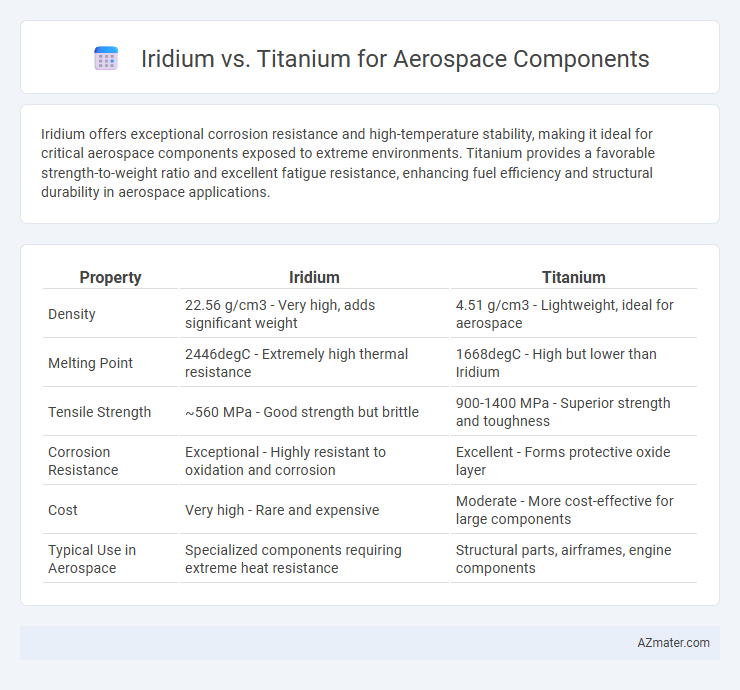Iridium offers exceptional corrosion resistance and high-temperature stability, making it ideal for critical aerospace components exposed to extreme environments. Titanium provides a favorable strength-to-weight ratio and excellent fatigue resistance, enhancing fuel efficiency and structural durability in aerospace applications.
Table of Comparison
| Property | Iridium | Titanium |
|---|---|---|
| Density | 22.56 g/cm3 - Very high, adds significant weight | 4.51 g/cm3 - Lightweight, ideal for aerospace |
| Melting Point | 2446degC - Extremely high thermal resistance | 1668degC - High but lower than Iridium |
| Tensile Strength | ~560 MPa - Good strength but brittle | 900-1400 MPa - Superior strength and toughness |
| Corrosion Resistance | Exceptional - Highly resistant to oxidation and corrosion | Excellent - Forms protective oxide layer |
| Cost | Very high - Rare and expensive | Moderate - More cost-effective for large components |
| Typical Use in Aerospace | Specialized components requiring extreme heat resistance | Structural parts, airframes, engine components |
Introduction to Aerospace Materials
Iridium and titanium are critical materials in aerospace component manufacturing due to their unique properties. Iridium offers exceptional corrosion resistance and high-temperature stability, making it ideal for engine parts and high-stress environments. Titanium provides a superior strength-to-weight ratio and excellent fatigue resistance, which is essential for structural components requiring lightweight durability.
Overview of Iridium and Titanium
Iridium, a dense and corrosion-resistant platinum-group metal, offers exceptional high-temperature stability and oxidation resistance, making it ideal for aerospace components exposed to extreme environments. Titanium, characterized by its high strength-to-weight ratio, excellent fatigue resistance, and corrosion resistance, is widely used in aerospace for structural parts requiring lightweight durability. Both metals serve critical roles in aerospace engineering where performance under demanding conditions is paramount.
Mechanical Properties Comparison
Iridium exhibits exceptional hardness and high melting point above 2446degC, making it highly resistant to wear and deformation under extreme aerospace conditions. Titanium offers outstanding strength-to-weight ratio, excellent corrosion resistance, and superior fatigue strength, essential for weight-sensitive aerospace components. While iridium excels in extreme temperature stability, titanium is preferred for structural elements due to its lighter weight and robust mechanical performance.
Corrosion and Oxidation Resistance
Iridium exhibits exceptional corrosion resistance and oxidation stability at high temperatures, making it ideal for aerospace components exposed to extreme environments. Titanium offers excellent corrosion resistance against many chemicals and maintains structural integrity with a favorable strength-to-weight ratio but can oxidize more readily at elevated temperatures than iridium. The superior high-temperature oxidation resistance of iridium contributes to longer service life in aerospace applications, while titanium balances corrosion resistance with lighter weight requirements.
Thermal Stability and Conductivity
Iridium exhibits exceptional thermal stability with a melting point of 2,446degC, making it highly suitable for aerospace components exposed to extreme temperatures. Its thermal conductivity, approximately 147 W/m*K, ensures efficient heat dissipation in high-stress environments. Titanium, while possessing good strength-to-weight ratio and melting point of 1,668degC, offers lower thermal conductivity around 22 W/m*K, limiting its effectiveness in heat transfer compared to iridium.
Weight and Density Considerations
Titanium offers a significant advantage in aerospace components due to its low density of approximately 4.5 g/cm3, which results in lighter parts that enhance fuel efficiency and overall aircraft performance. Iridium, with a much higher density near 22.6 g/cm3, is considerably heavier and generally reserved for specialized applications requiring extreme corrosion resistance and high-temperature stability. Weight-sensitive aerospace designs prioritize titanium to achieve optimal balance between strength, durability, and reduced mass.
Manufacturing and Machinability
Iridium offers exceptional corrosion resistance and high-temperature stability, making it suitable for aerospace components exposed to extreme environments, but it is challenging to machine due to its high density and hardness, requiring specialized manufacturing techniques such as electron beam melting or powder metallurgy. Titanium provides an excellent strength-to-weight ratio and is easier to machine with standard aerospace manufacturing processes like CNC milling and additive manufacturing, enabling efficient production of intricate parts. The choice between iridium and titanium hinges on balancing the need for superior durability versus manufacturability in aerospace applications.
Cost and Availability in Aerospace Industry
Iridium offers exceptional corrosion resistance and high melting points ideal for aerospace components but comes with significantly higher costs due to its rarity and complex extraction process. Titanium, while slightly less resistant to extreme conditions, provides a cost-effective alternative with widespread availability, making it the preferred metal for structural aerospace applications. The aerospace industry favors titanium for large-scale use due to its balance of strength, weight, and accessibility despite iridium's superior material properties in niche, high-performance scenarios.
Typical Aerospace Applications
Iridium's exceptional corrosion resistance and high melting point make it ideal for critical aerospace components such as spark plugs, rocket engine parts, and high-temperature thermal shields. Titanium's lightweight strength and excellent fatigue resistance are favored for structural airframe components, turbine blades, and fasteners in aerospace applications. Both metals are selected based on operational environment demands, with iridium excelling in extreme heat and titanium providing structural integrity under mechanical stress.
Future Trends in Material Selection
Iridium and titanium remain critical materials in aerospace component manufacturing due to their exceptional strength-to-weight ratios and corrosion resistance. Future trends indicate a growing preference for titanium alloys enhanced with novel processing techniques like additive manufacturing to reduce weight and cost while maintaining durability. Advances in iridium-based coatings and composites are expected to improve high-temperature performance in engine parts, supporting next-generation propulsion systems.

Infographic: Iridium vs Titanium for Aerospace Component
 azmater.com
azmater.com